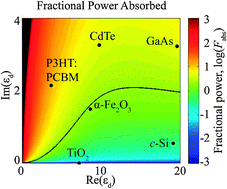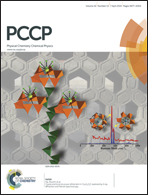Design considerations for enhancing absorption in semiconductors on metals through surface plasmon polaritons†
Abstract
Surface plasmon polaritons have attracted attention for energy applications such as photovoltaic and photoelectrochemical cells because of their ability to improve optical absorption in thin films. We show that surface plasmon polaritons enhance absorption most significantly in materials with small positive real permittivity and large positive imaginary permittivity, e.g. organics or CdTe. Additional losses, accounting for dissipation in the metal and the existence of a cutoff frequency above which polaritons are no longer bound, are incorporated into efficiency calculations. Owing to these losses, devices with optical absorption based solely on SPPs will necessarily always have a lower efficiency than that predicted by the Shockley–Queisser limit. Calculations are presented for specific materials, including crystalline and amorphous Si, GaAs, CdTe, a P3HT:PCBM blend, α-Fe2O3 and rutile TiO2, as well as for general materials of arbitrary permittivity. Guidelines for selecting absorber materials and determining whether specific materials are good candidates for improving optical absorption with SPPs are presented.


 Please wait while we load your content...
Please wait while we load your content...